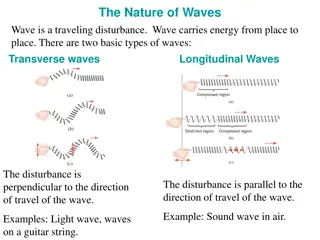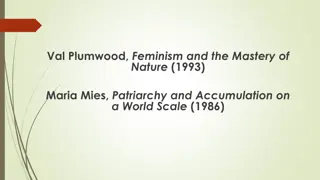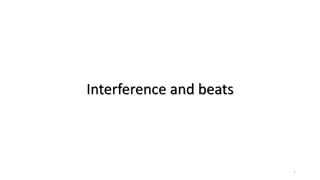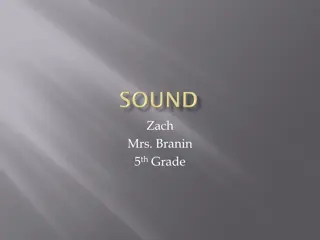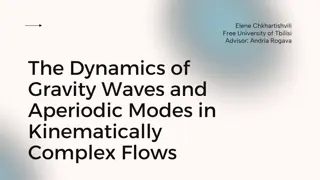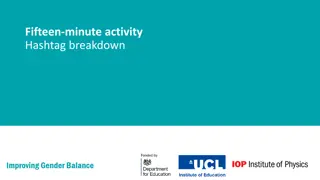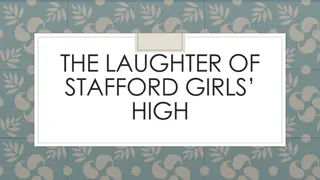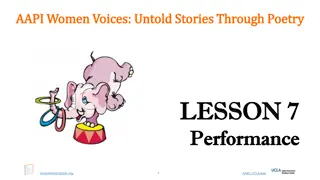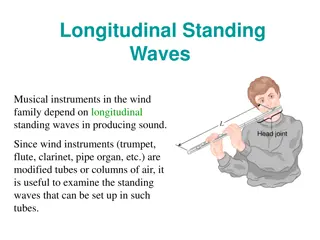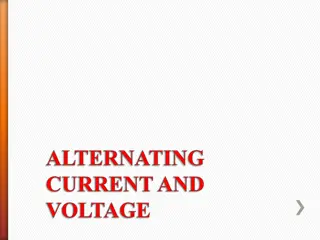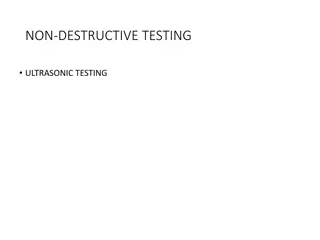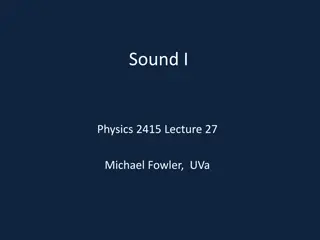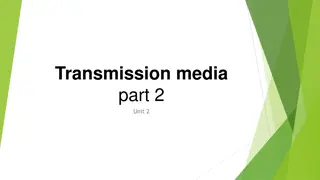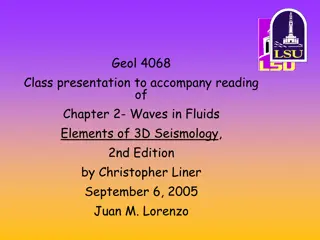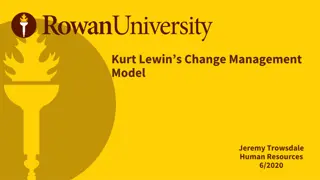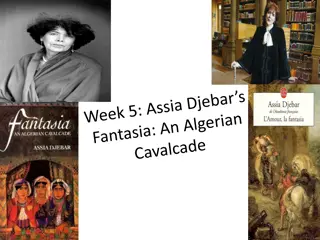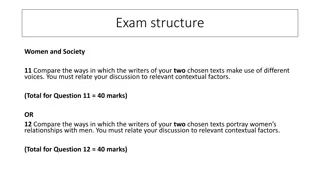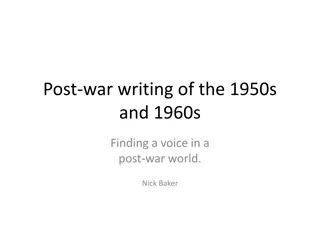Evolution of Feminism: Waves of Change and Critical Voices
Feminism is a diverse movement challenging societal treatment of women. It spans waves of activism, from suffrage to modern gender studies. Key figures like Mary Wollstonecraft advocated for women's rights, urging education and rational agency. Criticism and progress continue to shape feminist discourse worldwide.
Download Presentation

Please find below an Image/Link to download the presentation.
The content on the website is provided AS IS for your information and personal use only. It may not be sold, licensed, or shared on other websites without obtaining consent from the author. Download presentation by click this link. If you encounter any issues during the download, it is possible that the publisher has removed the file from their server.
E N D
Presentation Transcript
Activism Feminism describes the campaigns, activities, and texts concerned with challenging and transforming how women are treated and represented in society. It is a political movement and discourse that encompasses a diverse range of perspectives, theories, and methods. As well as analyzing patriarchal structures, feminist theory seeks to propose new ways for women to bring about social change.
First Wave From the end of the eighteenth century to the beginning of collective female political action in the form of the Suffragette and New Women s movements in Britain and the US, and the granting of partial (1918) and full (1928) franchise for women in Britain. They also fought for the right to own property.
Second Wave 1960s to 1980s. Women collectively campaigned on a broad range of issues including sexual health and contraception, pornography, domestic abuse, and gender discrimination in the workplace. Elaborate feminist theories.
Third Wave More global and plural view. Interdisciplinary: gender studies, postcolonial theory, queer theory, and postmodernism.
Where does feminist criticism begin? And whan I saugh he wolde nevere fyne To reden on this cursed book al nyght, Al sodeynly thre leves have I plyght Out of his book, right as he radde, and eke I with my fest so took hym on the cheke That in oure fyr he fil bakward adoun. And he up stirte as dooth a wood leoun, And with his fest he smoot me on the heed That in the floor I lay as I were deed. (Chaucer: Wife of Bath s Prologue. Ll. 788-796)
Mary Wollstonecraft, A Vindication of the Rights of Woman (1792) A philosophical essay against the social, political, and economic marginalization of women. At a time when the question of the rights of man was being debated in France and the US. The difference between men and women is not natural (ideology) but learned. Education should be changed, so that instead of making women sentimental and childlike (often domestic slaves), they become fully rational agents. Criticism: universal Enlightenment ideal of Reason.
Nineteenth Century John Stuart Mill introduced a parliamentary bill calling for the extension of enfranchisement to women. JS Mill (with Harriet Taylor, his wife), The subjection of women (1869): all women were repressed citizens, attacked British marriage laws (which denied women their own rights to children, land, and property). Ever more vocal suffragette movement: Millicent Fawcett, Emmeline Pankhurst. Feminism and feminist entered public usage by the 1890s. The 1928 Representation of the People Act.
Virginia Woolfs A Room of Ones Own (1929) Modernist Women: H. D., Edith Wharton, Zola Neale Hurston, and Djuna Barnes, Jean Rhys, Gertrude Stein, etc. Developed from two lectures that Woolf had delivered to women students in Cambridge. A woman must have money and a room of her own if she is to write fiction : the relationship between economics, education, and creativity. Intellectual freedom depends upon material things . Fiction is like a spider s web, attached ever so lightly perhaps, but still attached to life at all four corners. Often the attachment is scarcely perceptible; Shakespeare s plays, for instance, seem to hang there complete by themselves. But when the web is pulled askew, hooked up at the edge, torn in the middle, one remembers that these webs are not spun in mid-air by incorporeal creatures, but are the work of suffering human beings, and are attached to grossly material things, like health and money and the houses we live in.
Virginia Woolfs A Room of Ones Own 2 Transgressing the demarcations between traditional gendered spheres . Imaginatively she is of the highest importance; practically she is completely insignificant. She pervades poetry from cover to cover; she is all but absent from history. She dominates the lives of kings and conquerors in fiction; in fact she was the slave of any boy whose parents forced a ring upon her finger. Some of the most inspired words, some of the most profound thoughts in literature fall from her lips; in real life she could scarcely spell, and was the property of her husband. Literary androgyny: one must be woman-manly or man-womanly (Shakespeare, Keats, Sterne, Cowper, Lamb, and Proust) Chloe likes Olivia : has become a critical slogan for lesbian writing. A demystification of genius and a promise of the arrival of Shakespeare's sister. Three Guineas (1938): war and fascism in the context of women s domestic, political and cultural suppression, also unleashing women s potential to prevent war through liberation and education.
Simone de Beauvoirs The Second Sex (1949) One is not born, but rather becomes, a woman . No essential femininity ; femininity is itself constructed through certain cultural, social, and linguistic practices (social constructionism). Attack on the social institutions of motherhood and the family, discussion of female sexuality, just 5 years after French women were enfranchised. The Pope put the book on the list of works which Roman Catholics are forbidden to read and public campaign to have it banned. L vi-Strauss + Marx on myth (nature v. culture, femininity as a cultural product + an oppressive code to be exploded) Sex and gender as sharply separate (controversial). Biological essentialism v. social constructionism debate in feminism (and generally).
1960s Feminism is at the forefront of the subversive movements of the 60s. Consciousness Raising groups encourage women to talk about their experiences. The personal is political. Attacking Freudian psychoanalysis for its androcentrism: a representation of woman as lacking a sexual organ (Kate Millett s Sexual Politics and Germaine Greer s The Female Eunuch (both 1970)). Both contain literary analysis: reading canonical male writers for proof of misogyny, analysing the power politics, the stereotyping that women characters are subjected to and their impact on readers.
1970s More affirmative turn to female writers. Elaine Showalter: gynocritics, - woman as writer with woman as the producer of textual meaning, with the history, themes, genres, and structures of literature by women . From the female reader s estrangement from a male authored canon to a sense of female subculture: writer, character and reader.
1970s Elaine Showalter s A Literature of their Own: British Women Novelists from Bront to Lessing (1977), and Sandra Gilbert and Susan Gubar s The Madwoman in the Attic: The Woman Writer and the Nineteenth- Century Literary Imagination (1979). On the difficulties facing women writers: overt hostilities of their male contemporaries, and internalised sense of guilt about being women intellectuals and writers. Madness as an inevitable result if women invaded the masculine privilege of writing. Re-reading canonical women writers and extending the female canon. A debated issue: is there a separate female tradition or did each writer have to fight her own fight?
Some Unresolved Dilemmas With its own agendas and canons, does feminism also have an independent literary theory? Are the grievances voiced by feminists representative of the experiences of women in general? Gynocritics reclaim a past for women. Gender as one component that intersects with all the others of your identity.
Feminisms A diversification of feminisms from the late 70s: black feminism (e.g. Barbara Smith and bell hooks), feminist postcolonial studies and US Third World feminisms (e.g. Gayatri Chakravorty Spivak or Gloria E. Anzald a), lesbian feminism (e.g. Adrianne Rich, Bonnie Zimmerman and Judith Butler).
New French Feminism (70s onwards) Abstract academic discussions but connected to the radical movements of 68 and also specific radical feminist groups. Continue and complicate de Beauvoir s description of how historically woman has been constructed as the other of man (structuralism). They use esp. Derrida and Lacan to deconstruct the binary code (uncover the hierarchy in the binaries). Engagement with the theories of Jacques Lacan: the psychic development of the child, concentrating on the moment when it leaves behind its imaginary unity with the mother and enters into the symbolic order. Concept of criture f minine, a peculiarly female mode of expression which is supposed to reflect the physical closeness between infant and mother. Wishing to break away from patriarchal representations and their normative function in the socialisation of boys and girls, they proposed the language of irrationality as a possible subversion of the rigours of logic.
New French Feminism 2 Hysteria was hailed as a specifically female transgressive language: chaotic , associative - antidote to literary styles and modes of philosophical reasoning which defined women as inferior to men by celebrating the opposite of patriarchal rationality as woman s imaginative and intellectual sphere, they alienated many women who felt that this position was a stab in the back to the longstanding struggle to have women s rationality recognised. Strategic essentialism: a woman s body determines not only her identity but also a mode of writing and thinking fundamentally different from and in revolt against masculine modes
Lcriture fminine Coined in H l ne Cixous s The Laugh of the Medusa (1976). Woman must write her self: must write about women and bring women to writing Woman must put herself into the text as into the world and into history by her own movement. Using Lacan s ideas that the structure of language is centred by the Phallus, and that language within the Symbolic Order is representational, where a single signifier is connected to a single signified, Cixous argues that the subject position of woman or the feminine is on the margins of the Symbolic, and thus less firmly anchored and controlled by the Phallus. The psychoanalytic concept that woman is constituted by lack because of the lack of a penis. female unconscious is less repressed, less radically separated from consciousness. Using Derrida s idea of play, Cixous notes that woman is decentred, and therefore freer to move and create.
Lcriture fminine 2 Feminine writing is associated with the Lacanian Real, with the maternal body, which is barred from the Symbolic Order; she associates representational writing with the Symbolic, and non-representational writing with the female and maternal bodies. L criture feminine comes from the female body, but men can write from that position as well. She describes l criture feminine through a variety of metaphors, including milk, orgasm, honey, and the ocean; she claims that l ecriture feminine serves as a disruptive and deconstructive force, shaking the security and stability of the phallogocentric Symbolic Order, and therefore allowing more play in gender, writing, and sexuality for all language-using subjects.
Luce Irigaray (b. 1932) Belgian-born feminist philosopher and practicing psychoanalyst (trained with Jacques Lacan). Focus on female subjectivity and language, especially the language of philosophy as the site of the exclusion or marginalisation of women. Not patricide (Freud) but matricide is the foundational cultural act: the suppression of women/material body/nature. Attacks Freudian and Lacanian psychology for conceptualising femininity as lack (castration). Language is the symbolic order that defines what is real to us (Lacan). Phallocentric language disables the articulation of femininity.
Luce Irigaray (b. 1932) Promotes re-examining mother-daughter relationships as a hope for new female identities outside the male-dominated signifying system. Celebrates multiplicity and heterogenity in the understanding of femininity and calls for a separate parler femme : a talk by, about and between women. Also and activist in women s movements in France and Italy.
Hlne Cixous (b.1937) Theorist, poet, novelist, playwright, philosopher, and literary critic Born in Oran, Algeria, in1937 of Spanish/French and Jewish/German descent. Entered the English-speaking literary scene with the publication of The Laugh of the Medusa (1976[1975]) criture f minine: both theory and practice. A mode of writing that represents what is repressed in the Symbolic order (Derrida and Lacan). Revolutionary articulation of non-hierarchical difference as opposed to a phallocentric language based on binary oppositions like man/woman, mind/body, self/other, where the first term is invariable dominant.
Hlne Cixous 2 Writing that echoes the rhythms and processes of women s bodies, writing that is forceful and fluid, writing that undermines the unitary, authorial I, opening space for multiple voices and perspectives within a single text. Based on the body (essentialist?), but more about behaviour: ways of relating. Masculine: censorship, order, and binary logic vs. Feminine: censorship, order, and binary logic. Not mutually exclusive: men can potentially enter into feminine relational modes (bisexuality: both potentials present in individuals). Exemplary of revolutionary writing are men, such as Shakespeare and Franz Kafka. Later Cixous discovers the Brazilian writer Clarice Lispector.
Julia Kristeva (b. 1941) Writer, theorist and literary critic, also trained as a psychoanalyst (contributor to Tel Quel with e.g. Barthes and Foucault). To restore the body and psychic life to structuralist theories of language. Semiotic experience prior to Lacan s symbolic order of language: extra-linguistic bodily desires and psychic drives which emerge in language through indicators like rhythm, tone, metaphor, and figure. Social life is conducted through the symbolic order of language, which is rigid, strictly coherent, and authoritative (Freudian Law of the Father). The semiotic is feminine and associated with maternal attachment. Infant induction into the symbolic realm of language: suppression of the Semiotic, rejection of the mother.
Julia Kristeva 2 The preverbal child and the poet offer semiotic expressions that derail symbolic order, engaging in imaginative and radical practices that contest the coherent authority of language. Poetry is particularly capable of semiotic signification, insofar as the creative manipulations of tone, pitch, cadence, rhythm, and metaphor express the unconscious. Kristeva aligns semiotic expression to anti-authoritarianism, pitching a creative femininity against the rigid masculinity of the symbolic. Linguistically coherent subject is constituted by the abjection of this original maternal relationship, theorizing that the subsequent sexual discrimination and oppression of women both derives from and repeats this original abjection.
The abject Abjection refers to the negative reaction by which a subject severs themselves from an object with which they were in contact, is critical in the formation of infant identity. It entails an affective repulsion registered bodily pre-Oedipal child is en route to language and the law of the father which necessarily entails the supplanting of the mother.Although the maternal function leaves women abject, Kristeva notes that it also endows them with the radical potential of the semiotic body. Abjection is the civilized response to anything that reminds us of the drives and desires we have thrown into the unconscious through repression during the Oedipal phase of development. The abject is what culture throws away, its garbage, or its waste products; e.g. excrement, blood (especially menstrual blood), and dead bodies.
The abject Things that are abject create a feeling of horror or disgust in the adult civilized viewer because they remind him or her of the time before differentiated selfhood; they threaten to dissolve the boundaries of the self and to return the viewer to a non-differentiated state of egolessness that is frightening to the self. (Horror films)




